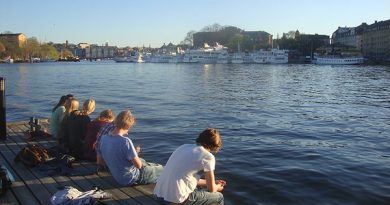The Arctic from space: Warming, thaw and melt

In space, everyone can see the Arctic heating up.
That’s the message from NASA scientists in a new study published in the journal WIREs Climate Change. The report presents decades of data, mostly collected by satellite, about temperature, ice, snow and weather patterns.
The Arctic trends show warmer temperatures, less sea ice, reduced snow cover and increased glacial ice melt, according to the study.
They also show, for the most part, accelerated thaw and melt in recent years. And they show atmospheric trends — in air-pressure systems, cloud cover and the light-reflecting quality known as albedo — that are related to changes documented on land and at sea. But Arctic changes have not been uniform or adhering to simple linear patterns, said study co-author Josefino Comiso, a senior research scientist at NASA’s Cryosphere Sciences Laboratory. “There are a lot of processes in the Arctic that we don’t completely understand,” Comiso said.
Consistent trend
Temperature trends show the Arctic warmed about 1 degree per decade, on average, between 1981 and 2012. Compare that to the global per-decade average of 0.3 degrees over the same period, according to NASA. Temperatures have been tracked over land, sea and sea ice; there have been regional and year-to-year variations, but the trend is consistent, the study says. The observed Arctic “amplification” is consistent with predictions of temperature models, the report says.
Globally, temperature rises have moderated since 1998, though there were two years since then that are considered record highs, Comiso said. But Arctic temperatures have continued to rise during that period, albeit with some regional deviations. “Overall, if you look at the decadal changes, then there is good tracking of the models with in-situ measurements,” he said.
Sea ice has declined 3.8 percent per decade overall, but 11.5 percent per decade in the summer and fall seasons, the report said. “It goes up and down from one year to another, but there’s this definite trend, especially in the summer,” Comiso said.
Spring snow cover — an important factor in the Arctic climate mix — has declined at a rate of 2.1 percent per decade from 1967 to 2012, with much of the reduction attributed to earlier spring melt, the report says. Snow cover is not only a “sensitive indicator of climate change” but also “a powerful regulator of surface and near surface air temperature because of its low thermal conductivity and high albedo,” the study points out.
Greenland ice sheet
The Greenland ice sheet lost mass at a rate of 34 gigatons a year from 1992 to 2001, but the melt accelerated in the years after that, according to data collected and synthesized by NASA. Average Greenland ice sheet melt from 2002 to 2011 was 215 gigatons tons a year, according to the NASA calculations.
The world’s glaciers lost 226 gigatons tons a year from 1971 to 2009, with the loss increasing to an annual rate of 275 gigatons from 1993 to 2009, according to NASA figures.
The atmospheric phenomenon of Arctic Oscillation — the atmospheric-pressure interplay between the Arctic and lower latitudes — does not appear to be directly linked to sea-ice levels, according to data measured from space, the NASA report says. “It doesn’t mean that it’s not correlated with it. It just means the climate system in the Arctic is more complicated than some people think,” Comiso said.
The Arctic Oscillation pattern was largely negative in the 1980s, then in the early 1990s switched to largely positive, leading some scientists to believe that the sea-ice shrinkage since the early 1990s was linked to the switch in patterns, Comiso said. But in the past decade, the Arctic Oscillation pattern has switched back and forth, while sea ice levels have continued to fall, he said.
When the Arctic Oscillation is in a negative phase, high pressure sits over the Arctic and low pressure moves over the middle latitudes, keeping weather warmer in parts of the north and stormier and colder than normal in temperate latitudes, according to the National Snow and Ice Data Center. When the Arctic Oscillation is positive, low pressure is in the Arctic, meaning wetter weather in the north and warmer weather in more southern latitudes.
Contact Yereth Rosen at yereth(at)alaskadispatch.com
Canada: Missing sea ice data found in crusty Canadian algae, CBC News
Finland: Walkers warned – Finland’s sea ice could be thinner than it looks, Yle News
United States: Arctic sea ice sends mixed messages about how rapidly it’s melting, Alaska Dispatch



